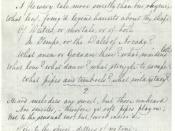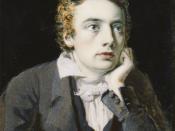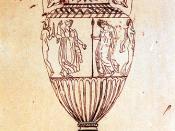The casual reader of John Keats' poetry would most certainly be impressed by the exquisite and abundant detail of it's verse, the perpetual freshness of it's phrase and the extraordinarily rich sensory images scattered throughout it's lines. But, without a deeper, more intense reading of his poems as mere parts of a larger whole, the reader may miss specific themes and ideals which are not as readily apparent as are the obvious stylistic hallmarks. Through Keats' eyes, the world is a place full of idealistic beauty, both artistic and natural, who's inherent immortality, is to him a constant reminder of that man is irrevocably subject to decay and death. This theme is one which dominates a large portion of his late poetry and is most readily apparent in three of his most famous Odes: To a Nightingale, To Autumn and on a Grecian Urn. In the Ode to a Nightingale, it is the ideal beauty of the Nightingale's song - as permanent as nature itself - in the Ode on a Grecian Urn, it is the perfection of beauty as art - transfixed and transfigured forever in the Grecian Urn - and in the Ode to Autumn it is the exquisiteness of the season - idealised and immortalised as part of the natural cycle - which symbolise eternal and idealistic images of profound beauty.
In Ode to a Nightingale, Keats uses the central symbol of a bird to exemplify the perfect beauty in nature. The nightingale sings to the poet's senses whose ardour for it's song makes the bird eternal and thus reminds him of how his own mortality separates him from this beauty. The poem begins: "My heart aches, and a drowsey numbness pains" (Norton 1845). In this first line Keats introduces his own immortality with the aching heart...


